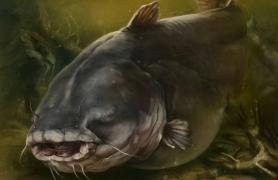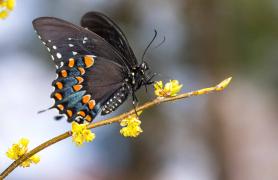Each month, we highlight research MDC uses to improve fish, forest, and wildlife management.
Invasive Species Management
Asian Longhorned Beetle Survey
What’s black with white spots and long, curved antennae?
“The Asian longhorned beetle!” said MDC Forest Entomologist Robbie Doerhoff.
MDC is asking Missourians who own swimming pools to keep an eye out for this invasive forest pest in July and August.
Why swimming pools?
“They’re basically giant insect collectors, trapping anything that falls in,” Doerhoff said.
The adult beetles are cool-looking insects, but their larvae tunnel under the bark and into the heartwood of native trees, eventually killing them. The Asian longhorned beetle is currently devastating trees in parts of Massachusetts, New York, and Ohio.
“The goal is to keep them out of Missouri, but if they are here, we want to know about it,” Doerhoff said.
“While this pest can be stopped, thousands or even hundreds of thousands of trees may be cut down in the process,” Doerhoff said. “Finding an Asian longhorned beetle infestation early means fewer trees will be removed. In an urban area, this is especially important because trees benefit communities in many ways, from storm water mitigation to savings on home energy costs.”
Asian longhorned beetle infestations in other states have been the result of the beetle’s larvae hitching a ride in the wood packaging material used to secure heavy freight during shipping from Asia. It’s also a pest that can hitchhike in firewood, allowing this tree-killer to move long distances during a weekend camping trip.
“Our Asian longhorned beetle pool survey is a total citizen-science effort. Throughout the months of July and August, we’re asking people with pools to check their filters and email us photos of large beetles they find,” Doerhoff said.
Asian Longhorned Beetles at a Glance
- Larvae kill native trees, including maple, elm, and buckeye
- No known populations in Missouri
- Early detection will help save trees
- Check your home pool filter and send photos of large beetles to forest.health@mdc.mo.gov
What to Look for
- Two long black-and white antennae
- Shiny black body with white spots
- Six legs
- 1–1½ inch-long body
Don’t move firewood!
Learn more about Asian longhorned beetles at short.mdc.mo.gov/Zhg
Also In This Issue


This Issue's Staff
Editor - Angie Daly Morfeld
Associate Editor - Larry Archer
Staff Writer - Bonnie Chasteen
Staff Writer - Heather Feeler
Staff Writer - Kristie Hilgedick
Staff Writer - Joe Jerek
Art Director - Cliff White
Designer - Shawn Carey
Designer - Les Fortenberry
Designer - Marci Porter
Photographer - Noppadol Paothong
Photographer - David Stonner
Circulation - Laura Scheuler






















